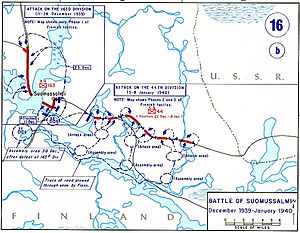The Battle of Suomussalmi was fought between Finnish and Soviet forces in the Winter War. The action took place from around December 7, 1939 to January 8, 1940.
The outcome was a major Finnish victory against vastly superior forces. In Finland, the battle is still seen today as a symbol of the entire Winter War itself.
Course of battle[ ]

Diagram of the Battle of Suomussalmi from November 30 to December 8, 1939. The Soviet 163rd Division advanced to the town of Suomussalmi.
On November 30, 1939, the Soviet 163rd division crossed the border between Finland and the Soviet Union and advanced from the north-east towards the village of Suomussalmi. The Soviet objective was to advance to the city of Oulu, effectively cutting Finland in half. This sector had only one Finnish battalion (Er.P 15), which was placed near Raate, outside Suomussalmi.
Suomussalmi was taken with little resistance on December 7 (only two incomplete companies of covering forces led a holding action between the border and Suomussalmi), but the Finns destroyed the village before this, to deny the Soviets shelter, and withdrew to the opposite shore of lakes Niskanselkä and Haukiperä.
The first extensive fight started on December 8, when Soviet forces began to attack across the frozen lakes to the west. Their attempt failed completely. The second part of Soviet forces led the attack to the northwest on Puolanka, that was defended by the Er.P 16 (lit. 16th detached battalion), that had just arrived. This attempt also failed.
On December 9, the defenders were reinforced with a newly founded regiment (JR 27). Colonel Hjalmar Siilasvuo was given the command of the Finnish forces and he began immediate counter-measures to regain Suomussalmi. The main forces advanced on Suomussalmi, but failed to take the village, suffering serious losses.
On December 24, Soviet units counterattacked, but failed to break through the surrounding Finnish forces.
Reinforced with two new regiments (JR 64 and JR 65), the Finns again attacked on December 27. This time, they took the village, and the Soviets retreated in panic over the surrounding frozen lakes.
During this time, the Soviet 44th Division had advanced from the east towards Suomussalmi. It was entrenched on the road between Suomussalmi and Raate and got caught up in the retreat of the other Soviet forces.
Between January 4 and January 8, 1940, the 44th Division was divided into isolated groups and destroyed by the Finnish troops (in a tactic known as motti), leaving much heavy equipment for the Finnish troops.[3]
Outcome[ ]
The battle resulted in a major victory for the Finns. If the Soviet Union had captured the city of Oulu, the Finns would have had to defend the country on two fronts and an important rail link to Sweden would have been severed. The battle also gave a decisive boost to the morale of the Finnish army.
In addition, Finnish forces on the Raate-Suomussalmi road captured a large amount of military supplies, including tanks (43), field-guns (71), trucks (260), horses (1,170), anti-tank guns (29) and other weapons, which were greatly needed by the Finnish army.
Analysis[ ]
The battle of Suomussalmi is often cited as an example how a small force, properly led and fighting in familiar terrain, can defeat a vastly numerically superior enemy. Factors which contributed to the Finnish victory included:
- Finnish troops having higher mobility due to skis and sledges; in contrast, Soviet heavy equipment confined them to roads.
- Finnish strategy was flexible and often unorthodox, for example, targeting Soviet field kitchens, which demoralized Soviet soldiers fighting in a sub-Arctic winter.
- Soviet army being poorly equipped, especially with regard to winter camouflage clothing.
- Finnish army had very high morale: they were defending their homes, religion, motherland and way of living against bolshevism. Soviet troops had only political reasons for their attack, and consequently lost their will to fight soon despite their continual political mind control of army.
- Soviet counter-intelligence failures: Finnish troops often intercepted the Soviet communications, which relied heavily on standard phone lines.[4]
- Finnish troops' equipment being well suited for warfare in deep snow and freezing temperatures.
- Soviet objective to cut Finland in half across the Oulu region - while appearing reasonable on a map, this was inherently unrealistic, as the region was mostly forested marshland, with its road network consisting mainly of logging trails. Mechanized divisions had to rely on these, becoming easy targets for the mobile Finnish ski troops.
- Simplicity where needed, as the final assault was a simple head-on charge, decreasing the chances of tactical errors. Rough weather also favoured comparatively simple plans.
- The Soviet Red Army was still suffering from the aftermaths of Stalin's army purges in the 1930s, with many replacement officers being incompetent and inexperienced.[5]
References[ ]
Citations[ ]
- ↑ 1.0 1.1 Kulju 2007, p. 195. The first Finnish reports estimated 600 dead, 162 missing and 1,200 wounded, but later some men died of their wounds.
- ↑ (Finnish)(Russian) Suomalaiset ja venäläiset tutkijat etsivät yhdessä totuutta talvisodasta
- ↑ The Mighty Finn - War Nerd, the eXile, Issue 254, December 29, 2006
- ↑ Snow and Slaughter at Suomussalmi - Hughes-Wilson, John - Military History, January/February 2006, page 50
- ↑ World War II - Willmott, H.P. et al., Dorling Kindersley Publishers Ltd, 2004
Bibliography[ ]
- Kulju, Mika (2007) (in Finnish). Raatteen tie : Talvisodan pohjoinen sankaritarina. Helsinki: Ajatus kirjat. ISBN 978-951-20-7218-7.
External links[ ]
- Battle of Suomussalmi (from www.winterwar.com)
Coordinates: 64°53′18″N 28°53′20″E / 64.88833°N 28.88889°E
The original article can be found at Battle of Suomussalmi and the edit history here.
